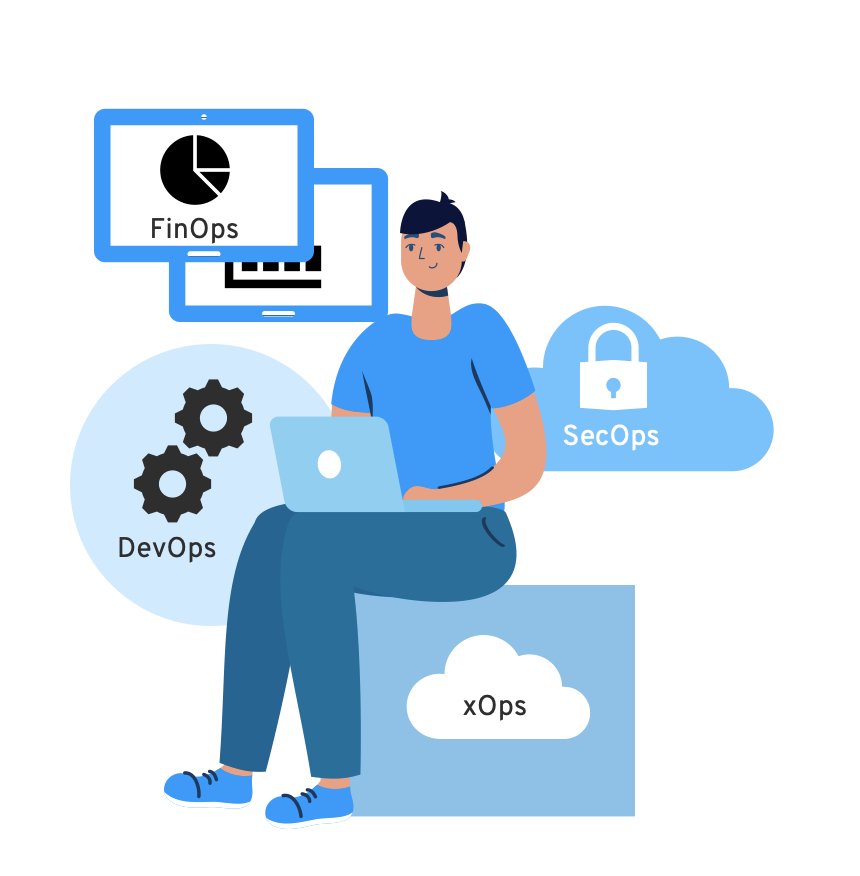What Does the Cloud Offer my Organization?
Often, we take for granted the simplicity of the cloud, how easily we can deploy an application or a microservice. We forget how much the cloud has transformed IT operations. What we can do with a cloud-native architecture – whether public, private or hybrid – has fundamentally changed what and how quickly IT can deliver for an organization.
The operational efficiencies that can be realized when using a cloud-native, or cloud-first, approach have gone beyond changing how IT can impact an organization and into how we invest in the future of our organizations. In today’s digital world, the reach of IT has extended beyond the data center and into the hands and minds of everyone in an organization. Every day, more and more processes are digitalized, more and more data is collected, and more and more non-technical staff rely on IT to continue to deliver results throughout your organization.
Cloud Operations Strategy

Architecting structures for success
A structured approach toward your cloud investment focuses on four areas: DevOps (development operations), SecOps (security operations), FinOps (financial operations), and xOps (traditional operations).
- DevOps is a project management methodology that affords your organization t
he ability to invest in a combination of culture, processes, and tools to increase the pace at which your organization’s digital strategy takes shape. - SecOps looks to leverage cloud-native tooling to achieve an automated approach that monitors systems and activity for security compliance.
- FinOps works to manage an organization’s IT spending by taking preemptive steps, such as implementing governance and compliance controls, to monitor your cloud subscriptions and resource consumption.
- xOps looks to assist teams in transitioning current processes and tech skills into the cloud and away from on-prem resources. Understanding the impact that IT can have on each of these operational processes holds the key to revealing the true benefits of a successful cloud engagement.
The cloud offers organizations more than a way to migrate away from on-prem hardware management; it offers organizations a better way to consume IT resources. By not focusing on how to maximize hardware investment, we can turn our focus on how to build infrastructure and applications that consume Storage, Compute and Network resources at their most granular levels, thereby reducing the cost of per-capita resource consumption.
Motivations for increased cloud adoption
Help business become more scalable, performant, secure and future-ready
“Because the CIO told us to,” is not the reason to start a cloud migration engagement. The cloud cannot benefit an organization solely by utilization, there must be additional, complementary goals that are realized along with any cloud engagement that prove the value of investment. This can be seen by contrasting the cost benefits of a lift and shift approach to cloud adoption versus an application modernization approach.
“Because the CIO told us to,” is not the reason to start a cloud migration engagement. Share on X
With lift and shift, we take virtual machines and migrate them as directly as we can from our on-prem hypervisor to a hypervisor in a public cloud. When selecting a lift and shift strategy, the goal is the decommissioning of hardware within an on-prem ecosystem; an apples-to-apples migration, as it were. However, the cost of a “cloud apple” and the cost of an on-prem apple are not the same – dollar for dollar, in most instances, a lift and shift only strategy will result in higher spending over time. The only efficiency realized here is in hardware management – your IT team will no longer need to focus on maintaining the hardware upon which your systems run, as that has been offloaded to the cloud.
Cloud Migration Strategies
Bringing your vision to the cloud
Let us look at two different approaches to cloud migration. For this example, we will look at a simple web application consisting of three tiers: Presentation tier (or web-based front end), Application tier (Code/Logic that makes the application “do” what it needs to), and Data Tier (database(s) and storage repositories). For our purposes, let us assume the application in our example is currently deployed on-prem using a monolithic approach, with each application tier occupying several Virtual Machine (VM) instances. In choosing to migrate this application the cloud, we will compare a Lift and Shift migration approach with an application modernization migration approach to highlight the differences in planning, execution and investment.
| Lift and Shift | Application Modernization | |||
| Activity |
|
| ||
| What is achieved |
|
| ||
| Length of Engagement |
|
| ||
| ROI |
|
| ||
| Skills Required |
|
| ||
| Future Investments |
|
|
The Best Path Forward
So, which one is better? Great question! The answer will require context, though, as each deployment will have different constraints, considerations and goals that must be met. There are more than just these two approaches that can help you successfully proceed with your Cloud Migration project. Navigating through a cloud migration can be an overwhelming task – understanding architecture, billing, and migration strategies can be a full-time job. Engage with experts to help iterate through your planning process. Engage with technologists who have experience with the platform and products that you are using. Engage with a partner that you trust.


